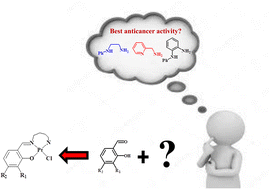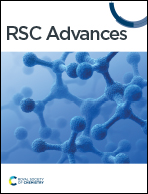Tuning anticancer properties and DNA-binding of Pt(ii) complexes via alteration of nitrogen softness/basicity of tridentate ligands†
Abstract
Nine tridentate Schiff base ligands of the type (N^N^O) were synthesized from reactions of primary amines {2-picolylamine (Py), N-phenyl-1,2-diaminobenzene (PhN), and N-phenyl-1,2-diaminoethane(EtN)} and salicylaldehyde derivatives {3-ethoxy (OEt), 4-diethylamine (NEt2) and 4-hydroxy (OH)}. Complexes with the general formula Pt(N^N^O)Cl were synthesized by reacting K2PtCl4 with the ligands in DMSO/ethanol mixtures. The ligands and their complexes were characterized by NMR spectroscopy, mass spectrometry and elemental analysis. The DNA-binding behaviours of the platinum(II) complexes were investigated by two techniques, indicating good binding affinities and a two-stage binding process for seven complexes: intercalation followed by switching to a covalent binding mode over time. The other two complexes covalently bond to ct-DNA without intercalation. Theoretical calculations were used to shed light on the electronic and steric factors that lead to the difference in DNA-binding behavior. The reactions of some platinum complexes with guanine were investigated experimentally and theoretically. The binding of the complexes with bovine serum albumin (BSA) indicated a static interaction with higher binding affinities for the ethoxy-containing complexes. The half maximal inhibitory concentration (IC50) values against MCF-7 and HepG2 cell lines suggest that platinum complexes with tridentate ligands of N-phenyl-o-phenylenediamine or pyridyl with 3-ethoxysalicylimine are good chemotherapeutic candidates. Pt-Py-OEt and Pt-PhN-OEt have IC50 values against MCF-7 of 13.27 and 10.97 μM, respectively, compared to 18.36 μM for cisplatin, while they have IC50 values against HepG2 of 6.99 and 10.15 μM, respectively, compared to 19.73 μM for cisplatin. The cell cycle interference behaviour with HepG2 of selected complexes is similar to that of cisplatin, suggesting apoptotic cell death. The current work highlights the impact of the tridentate ligand on the biological properties of platinum complexes.



 Please wait while we load your content...
Please wait while we load your content...